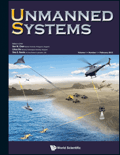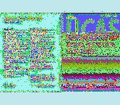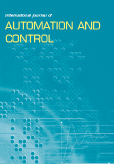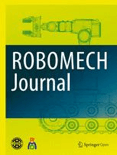
Unmanned Systems
Scope & Guideline
Shaping the Landscape of Control and Optimization
Introduction
Aims and Scopes
- Control Systems and Algorithms:
Research in this area focuses on the development and optimization of control strategies for unmanned systems, including adaptive control, robust control, and reinforcement learning approaches. - Navigation and Path Planning:
This scope encompasses innovative methodologies for autonomous navigation, including machine learning, optimization techniques, and real-time path planning algorithms for various environments. - Sensor Integration and Perception:
Studies in this area explore the integration of various sensors (e.g., LiDAR, cameras) for improved perception, localization, and mapping capabilities in unmanned systems. - Multi-Agent Systems and Coordination:
Research on coordination strategies for fleets of unmanned vehicles, including game-theoretic approaches, formation control, and collaborative task allocation. - Applications of Unmanned Systems:
This scope covers diverse applications of unmanned systems, ranging from agriculture and surveillance to disaster response and environmental monitoring. - Modeling and Simulation:
Contributions in modeling and simulation techniques for unmanned systems to predict performance and assess system behavior in various scenarios.
Trending and Emerging
- Autonomous Navigation and Machine Learning:
There is a growing trend towards integrating machine learning techniques for enhancing autonomous navigation capabilities, reflecting the demand for smarter and more adaptable unmanned systems. - Swarm Intelligence and Cooperative Systems:
Research on swarm intelligence and cooperative multi-agent systems is on the rise, emphasizing the importance of collaborative strategies for efficiency and effectiveness in complex environments. - Real-Time Data Processing and Sensor Fusion:
An increasing focus on real-time data processing techniques and sensor fusion methods is evident, driven by the need for improved situational awareness and decision-making in unmanned operations. - Robustness and Fault-Tolerant Control:
The development of robust and resilient control systems that can handle uncertainties and faults is gaining prominence, especially in safety-critical applications. - Application-Specific Innovations:
Emerging research is increasingly targeting specific applications, such as precision agriculture, disaster response, and environmental monitoring, reflecting a shift towards practical and impactful implementations.
Declining or Waning
- Traditional Control Techniques:
There appears to be a reduced emphasis on classical control methods, as more researchers are gravitating towards adaptive and learning-based control approaches. - Basic UAV Design and Fabrication Studies:
Research focusing solely on the fundamental design and construction of UAVs without integrating advanced technologies or applications is becoming less prevalent. - Static Path Planning Algorithms:
The interest in static path planning methodologies seems to be waning as dynamic and adaptive planning techniques gain traction due to the need for real-time responsiveness. - Single-Agent Systems:
There is a noticeable shift away from research on single-agent systems towards multi-agent systems, highlighting a trend towards collaborative and swarm technologies. - Environmental Impact Studies:
While important, studies solely focused on the environmental impact of UAV operations are being overshadowed by more innovative applications and technological advancements.
Similar Journals

INTERNATIONAL JOURNAL OF CONTROL AUTOMATION AND SYSTEMS
Connecting Theory with Practice in Control Systems.INTERNATIONAL JOURNAL OF CONTROL AUTOMATION AND SYSTEMS is a distinguished scholarly journal published by the Institute of Control Robotics & Systems in collaboration with the Korean Institute of Electrical Engineers. Since its inception in 2003, the journal has contributed significantly to the domains of Control and Systems Engineering and Computer Science Applications, attaining a commendable Q2 ranking in both fields as of 2023, thereby positioning itself at the forefront of academic inquiry and innovation. With an ISSN of 1598-6446 and an E-ISSN of 2005-4092, this journal serves as a platform for disseminating cutting-edge research and advancements in control automation technologies. Although it operates under a subscription model, the journal maintains a high impact factor, underscoring its relevance and appeal to researchers, engineers, and students alike who seek to expand their knowledge and apply theoretical insights in practical scenarios. We invite you to explore and contribute to the ongoing discourse that shapes the future of automation and control systems.

MULTIBODY SYSTEM DYNAMICS
Pioneering Research in Multibody System ApplicationsMULTIBODY SYSTEM DYNAMICS is a prestigious peer-reviewed journal published by SPRINGER, dedicated to the field of multibody dynamics and its applications across various engineering disciplines. Established in 1997, this journal has become a leading forum for researchers and practitioners, showcasing innovative research and advancements in areas such as Aerospace Engineering, Mechanical Engineering, and Control and Optimization. With an impressive trajectory reflected in its Q1 rankings in multiple categories for 2023, including a notable rank of #20 in Control and Optimization, MULTIBODY SYSTEM DYNAMICS plays a crucial role in shaping the future of mathematical modeling and simulations within the engineering community. The journal offers a robust platform for the dissemination of high-quality research, fostering collaboration and dialogue among scientists and engineers worldwide. Interested contributors can expect their work to reach a significant audience, further enhancing their influence in various applications. The journal does not currently provide Open Access options, ensuring that submissions undergo rigorous peer review to maintain its high academic standards.

International Journal of Automation and Control
Elevating Standards: Discover the Latest in Automation and Control Technologies.Welcome to the International Journal of Automation and Control, a vital platform for research and discussion in the fields of Control and Systems Engineering, Hardware and Architecture, Industrial and Manufacturing Engineering, and Software. Published by InderScience Enterprises Ltd since 2007, this journal has gained recognition for its high-quality articles and innovative approaches, holding Q3 rankings in its primary fields and a commendable Q2 designation in Industrial and Manufacturing Engineering. While offering a robust mix of theory and practical applications, it aims to bridge the gap between academia and industry, fostering advancements in automation technologies. Researchers, professionals, and students will find invaluable insights and critical analysis that contribute to the evolving landscape of automation and control systems. Although currently not open access, the journal provides a comprehensive archive until 2024, ensuring accessibility to groundbreaking research that shapes the future of engineering. Join a community dedicated to exploring the challenges and achievements in automation and control.

International Journal of Heavy Vehicle Systems
Exploring the Future of Automotive EngineeringThe International Journal of Heavy Vehicle Systems, published by INDERSCIENCE ENTERPRISES LTD in the United Kingdom, is a pivotal resource for professionals and researchers in the fields of automotive and mechanical engineering. With an ISSN of 1744-232X and an E-ISSN of 1741-5152, this journal serves as an academic platform dedicated to exploring the latest innovations and technologies pertaining to heavy vehicle systems, including design, performance, and environmental impact. Boasting a Category Quartile of Q3 in both Automotive and Mechanical Engineering as of 2023, it ranks among the growing body of literature in these disciplines, indicative of its commitment to quality research. The journal is widely accessible through diverse open access options, encouraging the dissemination of knowledge within the academic community. By publishing cutting-edge studies and reviews, the International Journal of Heavy Vehicle Systems plays an essential role in advancing our understanding of heavy vehicle technologies, providing invaluable insight for engineers, researchers, and students eager to contribute to this dynamic field.

International Journal of Aeronautical and Space Sciences
Catalyzing Progress in Aeronautical and Space SciencesThe International Journal of Aeronautical and Space Sciences, published by Springer, is a prominent platform dedicated to advancing research and innovation in the fields of Aerospace Engineering, Control and Systems Engineering, Electrical and Electronic Engineering, and Materials Science. With an ISSN of 2093-274X and an E-ISSN of 2093-2480, the journal has established itself as a vital resource since its inception in 2011, currently offering insights that span a wide range of contemporary challenges and technological advancements in aeronautics and space exploration. Ranking in the Q2 category across multiple disciplines, including Aerospace and Control Engineering, signifies its recognized impact and quality within the academic community. Although not an open-access journal, it remains accessible to researchers, professionals, and students seeking to enhance their understanding of complex aerospace systems and their applications. The journal’s commitment to publishing high-quality research makes it indispensable for those aiming to contribute to, or stay informed about, the evolving landscape of aerospace technology.

ROBOMECH Journal
Transforming Ideas into Solutions in Robotics and Mechanical EngineeringROBOMECH Journal, published by SpringerNature, is a prominent open-access journal dedicated to the fields of robotics, mechanical engineering, and artificial intelligence. Established in 2014, the journal has quickly established itself as a vital platform for disseminating innovative research in control and optimization, instrumentation, and modeling and simulation, earning a commendable Q2 ranking in Mechanical Engineering and multiple Q3 rankings across other relevant fields in 2023. With a commitment to facilitating accessible knowledge sharing, ROBOMECH Journal promotes cutting-edge research that drives advancements in both theoretical frameworks and practical applications within the robotics community. Scholars, engineers, and professionals seeking to contribute to or stay informed about the latest developments in these dynamic fields will find the journal's rich array of articles invaluable. With its open-access model, all published research is freely available, ensuring wide dissemination and increased visibility for authors, thus fostering collaboration and innovation across disciplines.

Drone Systems and Applications
Transforming Ideas into Aerial SolutionsDrone Systems and Applications is an innovative open-access journal published by Canadian Science Publishing that commenced its journey in 2022 and is set to converge in 2024. With a keen focus on the interdisciplinary domains of Aerospace Engineering, Automotive Engineering, Control and Optimization, and Computer Science Applications, this journal seeks to advance the frontiers of knowledge surrounding drone technology and its myriad applications. Achieving notable rankings within various engineering and computer science categories, including being placed in the Q2 quartile in Automotive Engineering and Q3 quartiles in several other relevant fields, the journal exemplifies scholarly excellence and research impact. As an open-access publication, it ensures that cutting-edge research is readily available to a global audience, fostering progress in drone systems across multiple industries. For researchers, professionals, and students alike, Drone Systems and Applications serves as a vital platform for disseminating impactful findings and promoting collaborative advancements in this rapidly evolving field.

Systems Science & Control Engineering
Catalyzing Interdisciplinary Collaboration in Systems Science.Systems Science & Control Engineering, published by Taylor & Francis Ltd, stands out as a premier open-access journal devoted to the advancement of control systems, optimization methodologies, and artificial intelligence applications within engineering. Since its inception in 2013, the journal has garnered a strong reputation evidenced by its impressive categorization in 2023, ranking Q2 in Artificial Intelligence and achieving Q1 status in both Control and Optimization and Control and Systems Engineering. With a Scopus ranking that places it among the top tier of its fields—being positioned 7th in Control and Optimization—this journal serves as an essential resource for researchers, industry professionals, and students who are seeking to publish high-quality research and stay abreast of innovative developments. The journal emphasizes the integration of theoretical frameworks with practical applications, aiming to foster interdisciplinary collaboration and stimulate future research directions in systems science.

Journal of Unmanned Vehicle Systems
Advancing unmanned vehicle technology for a smarter future.Journal of Unmanned Vehicle Systems, published by CANADIAN SCIENCE PUBLISHING, is a leading peer-reviewed journal dedicated to advancing the field of unmanned vehicle technology. With an ISSN of 2291-3467, this journal provides an essential platform for researchers and professionals interested in the intersection of engineering, computer science, and control systems as they pertain to unmanned vehicles. The journal has achieved commendable rankings in Scopus, including a rank of #17/118 in Mathematics - Control and Optimization and #23/131 in Aerospace Engineering, reflecting its impact in these significant areas. As an open-access journal, it fosters global collaboration and accessibility, ensuring that innovative research in unmanned vehicle systems reaches a broad audience. The journal's objectives are to publish high-quality research articles, technical notes, and reviews that contribute to the understanding and development of autonomous systems. With its coverage spanning from 2013 to 2021, the Journal of Unmanned Vehicle Systems remains a vital resource for advancing discussions and knowledge in this rapidly evolving field.

Journal of Computational and Nonlinear Dynamics
Connecting Researchers with the Dynamics of Innovation.Welcome to the Journal of Computational and Nonlinear Dynamics, a leading publication in the fields of applied mathematics, control and systems engineering, and mechanical engineering, published by the esteemed American Society of Mechanical Engineers (ASME). With an ISSN of 1555-1423 and an E-ISSN of 1555-1415, this journal has been a vital resource since its inception in 2006, promoting high-quality research and innovative methodologies aimed at solving complex engineering problems. With a commendable impact in academic circles, it ranks in the Q3 quartile for Applied Mathematics and Control and Systems Engineering, and Q2 for Mechanical Engineering as of 2023. The journal facilitates the dissemination of research findings, theoretical advancements, and practical applications, making it an essential platform for researchers, professionals, and students looking to advance their knowledge and engage with cutting-edge dynamics research. While currently not available as an open-access publication, subscribers benefit from a wealth of scholarly articles that contribute to the academic community's understanding of computational and nonlinear dynamics in various engineering disciplines.